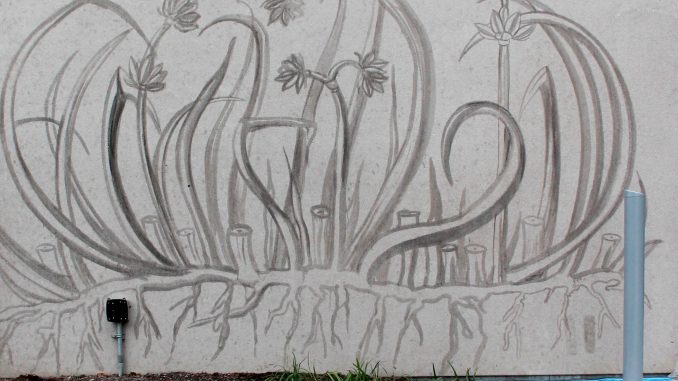
Most people consider the soot from car tailpipes waste or pollution. But for British artist Caroline Rothwell, carbon emissions are the main choice of medium in her artwork.
“I come from a family of scientists and industrial chemists, so I have always approached materiality with a slightly unusual styling point,” Rothwell said. “So every medium I use in my artwork always has a very particular meaning.”
Through a recent collaboration with the Office of Sustainability and Temple Contemporary, Rothwell created a mural on the Montgomery Garage’s north wall using the soot from emissions.
For Temple’s mural, she used emissions from one of the smokestacks located at Temple. All her artwork is generally small and detailed; this was the first time she painted something with the medium on such a large scale.
The image Rothwell created is of an threatened plant species in Philadelphia known as the Juncus alpinus. The main goal of the mural is to raise awareness for the environment, especially endangered plant species.
“I was very interested in connecting our relationship with our environment,” Rothwell said. “I really wanted to make that direct connection to Philadelphia.”
Robert Blackson, director of exhibitions and public programs for Temple Contemporary, met Rothwell in New York during studio visits through a residency program. He was immediately intrigued by the messages and concepts used in her artwork and wanted to bring the idea of using carbon emissions to Temple.
He spoke to administration and Kathleen Grady, Temple’s director of sustainability, in order to locate possible locations for the project. Once the parking garage was decided as the final location, Blackson took action in assisting Rothwell with collecting emissions for the project.
“Here at Tyler, we ground them down and sifted them,” Blackson said. “We had to mix that with water so that eventually the mural will go away.”
The fact that the mural will eventually disappear is also a theme with bringing awareness to the environment.
“I believe it will only have a lifespan of just a few months,” Blackson said. “The intention of it is that it will go away—it’s that sense of a cycle and composting.”
Grady also took deep interest in the goal of the mural. She hopes the mural will also shed light on the Office of Sustainability’s other initiatives, like its recent efforts of addressing climate change in hopes of having Temple become carbon-neutral by 2050.
“We really think it really helps frame the dialogue of carbon as a building block of life but also as this force that we’re dealing with in terms of climate change,” Grady said. “So that is something to get people to think about the different roles carbon plays in our lives.”
Alexis Rogers can be reached at alexis.rogers@temple.edu.



Be the first to comment